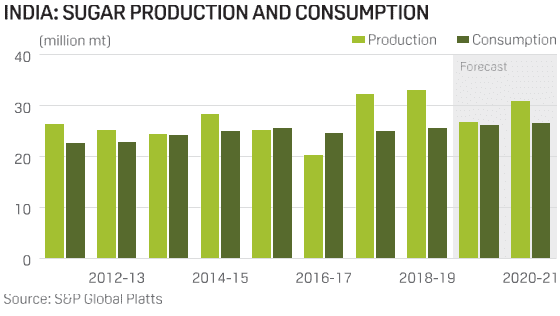
Sugary food is addictive. Isn’t it true? If you can restrain yourself when it comes to eating processed foods high in sugar, then it’s fantastic. Unfortunately, I’m not the one. I love sweets, desserts, cakes and everything that is made of sugar. Now, we are entering a new era. Despite the harm sugar does to our health due to over-consumption, it is enjoying a lucrative journey towards green-energy production.
Why the sudden spur? The major reason for this unforeseen growth that has taken place in recent years are the subsidies being provided by governments to producers of biofuels.
In fact, this sector has become so crucial to the clean energy initiative, it is no longer seen as simply a driver of growth within the food chain. Hence, let’s unfold the backstory of it.
Sugarcane and Indian Sugar Industry
After cotton, sugarcane is the second-largest cash crop in India. It is a hefty, perishable raw material that cannot be shipped across long distances and primarily utilized to make sugar.
The Indian sugar industry is one of the largest in the world, with over 800 mills producing about 25 million tons of sugar per year. The sector employs 3 million people and contributes to nearly 1.1% of India’s national GDP.

The sugar cane mills discards massive amounts of by-products including bagasse, molasses, press mud and other organic matter which have caused environmental concerns. According to estimates, sugarcane waste accounts for approximately 220-250 million tons per year.
The waste generated can adversely affect the environment if not managed properly. To lessen it, several sugar industries have come forward to create a value through this waste by the production of bio-cng.
Bio-CNG Fuel from Sugarcane Waste
Bio-CNG (Compressed natural gas) is a cleaner alternative fuel produced by converting organic matter into gas through anaerobic digestion (AD) technology which uses microorganisms such as bacteria or fungi within an oxygen-free environment. This process produces biogas consisting primarily of methane along with carbon dioxide (CO2) and trace amounts of hydrogen sulfide (H2S).
Bio-CNG generated from sugarcane waste also follows the anaerobic digestion process. Ten years ago, a research institute in Pune analyzed the potential of press mud—a waste product from sugarcane mills that is commonly discarded—to produce bio-CNG which resulted in a great success. Since, many sugar mills began to adopt this technology to generate bio-cng.
Case Studies on Mills using Bio-CNG
Several major sugar mills in India have already initiated to utilize their sugarcane waste materials fruitfully. Few examples are given below:
- Bannari Amman Sugars Limited (BASL) sugar mill in Tamil Nadu, which installed a bio-CNG plant with a capacity of 30 tons per day.
- Dalmia Bharat Sugar Mill in Kolhapur, Maharashtra, which installed a bio-CNG plant with a capacity of 35 tons per day.
- Dwarikesh Sugar Industries Limited sugar mill in Uttar Pradesh, which installed a bio-CNG plant with a capacity of 25 tons per day.
These plants use sugarcane waste such as bagasse, press mud, molasses, and spent wash as feedstock to produce bio-CNG, which is then used to power the mill’s boilers and generate electricity.
Overall, these case studies demonstrate that the use of bio-CNG made from sugarcane waste is a viable and sustainable solution for sugar mills in India. It not only helps reduce the mills’ environmental impact but also generates additional revenue streams and creates job opportunities.
Learn this blog also: Bio-CNG: An Air-Saving Alternative to Stubble Burning and a Lifesaver
Challenges, Future Prospects and Government Initiatives
The potential for growth in bio-CNG is immense. However, there are some challenges that need to be addressed before this technology becomes widespread across the country:
- Bio-CNG has yet to become a viable alternative fuel at large scale. There are no existing infrastructures for production and distribution, making it difficult for small companies to invest in their own equipment or technologies. Transportation and storage concerns also remain as constraints.
- Availability of sugarcane waste can vary seasonally, which can affect the commercial viability of CBG plants.
- The market for bio-CNG is still developing, and there may be a lack of awareness and acceptance of this fuel among consumers and businesses which can limit the growth of the industry.
However, the government has already launched several initiatives to promote the production and use of bio-CNG, such as the Sustainable Alternative Towards Affordable Transportation (SATAT) scheme, which aims to establish 5,000 bio-CNG plants across the country. Also, the government has already announced plans to promote the use of bio-CNG in the transportation sector and has set a target to produce 15 million tons of bio-CNG by 2025.
In the latest budget announcement in India, the government has emphasized the importance of promoting clean energy sources, including bio-CNG made from waste. The budget also proposed to reduce the customs duty on certain equipment used in bio-CNG production, such as biogas plant machinery, to encourage investment in this sector.
These announcements highlight the government’s commitment to promoting sustainable development and its recognition of the potential of bio-CNG made from agricultural waste to contribute to the country’s energy needs while reducing its carbon footprint.
Final Thoughts
Bio-CNG fuel from sugarcane waste is a renewable and sustainable energy source that has the potential to revolutionize the energy sector, especially in countries like India. Sugarcane is a major crop and the use of bio-CNG fuel from sugarcane waste has significant potential to promote sustainable development and contribute to the country’s energy security. Overall, bio-CNG fuel from sugarcane waste is a promising solution for the transition to a cleaner and more sustainable energy future.
Introducing the leading Bio CNG manufacturer in India! Discover sustainable energy solutions with our state-of-the-art facilities. Join the green revolution and reduce carbon footprint with Bio CNG. Visit our website now




